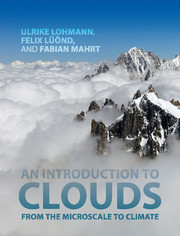Book contents
- Frontmatter
- Dedication
- Contents
- Preface
- List of symbols and acronyms
- 1 Clouds
- 2 Thermodynamics
- 3 Atmospheric dynamics
- 4 Mixing and convection
- 5 Atmospheric aerosol particles
- 6 Cloud droplet formation and Köhler theory
- 7 Microphysical processes in warm clouds
- 8 Microphysical processes in cold clouds
- 9 Precipitation
- 10 Storms and cloud dynamics
- 11 Global energy budget
- 12 Impact of aerosol particles and clouds on climate
- References
- Index
10 - Storms and cloud dynamics
Published online by Cambridge University Press: 05 June 2016
- Frontmatter
- Dedication
- Contents
- Preface
- List of symbols and acronyms
- 1 Clouds
- 2 Thermodynamics
- 3 Atmospheric dynamics
- 4 Mixing and convection
- 5 Atmospheric aerosol particles
- 6 Cloud droplet formation and Köhler theory
- 7 Microphysical processes in warm clouds
- 8 Microphysical processes in cold clouds
- 9 Precipitation
- 10 Storms and cloud dynamics
- 11 Global energy budget
- 12 Impact of aerosol particles and clouds on climate
- References
- Index
Summary
Convective precipitation originates from cumulus clouds, namely cumulus congestus (Cu con) and cumulonimbus (Cb); (Table 1.1, Figure 1.4b and Chapter 9). The prerequisite for precipitation from cumulus clouds is that the hydrometeors grow to precipitation size in a short time. This is most efficiently achieved in Cb, which by definition consists of water and ice and has the largest vertical extent and highest vertical velocities (Table 1.3). Precipitation can also fall from Cu con, but its precipitation is typically less heavy and in the form of short showers, whereas Cb has the potential to turn into a thunderstorm, owing to the coexistence of water and ice, which is a prerequisite for the formation of lightning and thunder (Section 10.2). The various types of thunderstorms can generally be grouped into three categories as follows.
Ordinary, isolated or pulse thunderstorms, which consist of only a single convective cell and last approximately 40 minutes to one hour.
Multicell thunderstorms, which consist of a number of cells in different stages of development and last for several hours.
Supercell thunderstorms, which also last several hours but, in contrast with multicell thunderstorms, consist of only one self-maintaining cell.
Supercell storms are the rarest type of thunderstorm, but the most violent.Whether a given thunderstorm turns out to be a single cell (Section 10.1), multicell or supercell (Section 10.3), depends on both the vertical shear of the horizontal wind (hereafter just referred to as the wind shear) and the static stability of the environment. The largest convective storms are mesoscale convective systems (Section 10.4). They include a large variety of mesoscale systems, such as squall lines, mesoscale convective complexes and tropical cyclones, which we will discuss in terms of their formation and transition into extratropical cyclones (Section 10.5). This chapter ends with a discussion of the observed changes in tropical and extratropical cyclones in the last decades and projected future changes.
Isolated thunderstorms and hail
An ordinary or isolated thunderstorm is also called a pulse storm because of its short duration (Table 1.3) and because it may generate another ordinary thunderstorm as it weakens. Thus this type of thunderstorm appears to occur in pulses. It undergoes a characteristic life cycle and is often accompanied by graupel and hail.
- Type
- Chapter
- Information
- An Introduction to CloudsFrom the Microscale to Climate, pp. 285 - 322Publisher: Cambridge University PressPrint publication year: 2016



